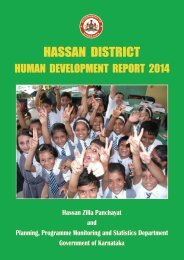Development
Raichur-DHDR-English-2014
Raichur-DHDR-English-2014
You also want an ePaper? Increase the reach of your titles
YUMPU automatically turns print PDFs into web optimized ePapers that Google loves.
Gender <strong>Development</strong><br />
opportunities and chances of<br />
personal growth. While boys are also<br />
affected by adolescent marriage,<br />
girls are affected in far larger<br />
numbers and with more intensity.<br />
The consequences for girls are<br />
especially dire, as they are usually<br />
compelled into early child bearing<br />
and social isolation. Adolescent<br />
brides will drop out of school and<br />
be exposed to higher risk of<br />
domestic violence and abuse,<br />
increased economic dependence,<br />
denial of decision-making power,<br />
inequality at home, which further<br />
perpetuates discrimination and low<br />
status of girls/women. Adolescent<br />
marriage is also associated with<br />
several health risks for the young<br />
mother, as early marriage may<br />
translate into repeated pregnancies<br />
at a tender age when the body is not<br />
fully prepared for child bearing.<br />
Girls aged 15-19 are more likely<br />
(66.6%) to experience delivery<br />
complications compared to 30-34<br />
year-old women (59.7%) and<br />
neonatal, infant and child mortality<br />
rates are much higher for younger<br />
girls. Risks of HIV/AIDS infection<br />
are higher among young girls as<br />
their negotiation skills and<br />
experience to ensure a healthy<br />
sexual life are less developed<br />
(Sahoo, 2011).<br />
8.10.3. The Present Study<br />
The study was undertaken in<br />
Kurudi village of Manvi taluk in<br />
Raichur District. The village lies at<br />
a distance of 22 kms from the taluk<br />
headquarters and has a pucca road<br />
connecting to Manvi. Being<br />
dependent primarily on<br />
agricultural occupations, the<br />
village represents a backward rural<br />
economy.<br />
A sample of 36 married women<br />
below the age of 30 years was<br />
chosen and for eliciting<br />
information about their marriage,<br />
family relations and child bearing<br />
issues, women below the age of 30<br />
years were specifically chosen for<br />
the study. The social group<br />
composition shows that majority<br />
(64 %) of them were from backward<br />
classes (OBC); 25% from SC-ST<br />
category; and 11% belonged to<br />
minority community. All the<br />
sample women belonged to BPL<br />
households since all of them<br />
possessed BPL cards.<br />
8.10.4. Average Age at marriage<br />
The respondents were not in a<br />
position to reveal their husband’s<br />
age correctly as is evident in the<br />
Figure 8.4. While the average for<br />
the sample women is less than 17<br />
years, it has been the lowest among<br />
minority communities and OBCs.<br />
However, the social group wise<br />
difference is not much. But what<br />
matters is the age difference<br />
between the couple. The average<br />
age difference among the sample is<br />
7.78 years and as high as 8.75<br />
years among minorities. This only<br />
indicates that girls are married off<br />
early and that too to a person quite<br />
older than her. However, as<br />
mentioned earlier, the age of<br />
husbands might not have been<br />
stated correct, but the age gap<br />
between husband and the wife has<br />
implications for family health as<br />
well as personal health.<br />
Adolescent<br />
marriage is also<br />
associated with<br />
several health<br />
risks for the<br />
young mother, as<br />
early marriage<br />
may<br />
translate into<br />
repeated pregnancies<br />
at a tender age<br />
when the body is<br />
not fully<br />
prepared for<br />
child bearing.<br />
185



